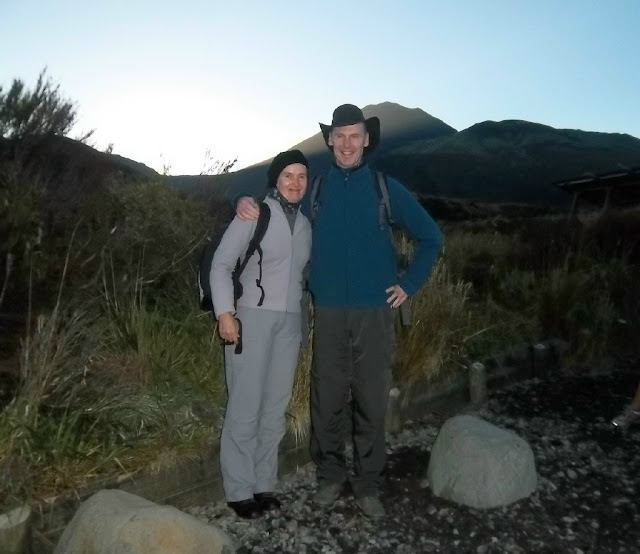Friday 24 February
We catch the train from Grafton down to Britomart carrying all our gear for the w/e. Tiritiri Matangi is an open reserve, a bird sanctuary, an island, and one of the few places where there’s a chance of spotting a kiwi in the wild. The trip is run by 360 Discovery and there are lots of DOC volunteers on the boat to give us info and advice. This is Mike’s birthday treat and has been booked for ages because we wanted to stay overnight (kiwis being nocturnal) and the DOC hut (Department of Conservation) is booked up a long way in advance. There are no shops or cafes so we’re taking all our food with us for the w/e. The island’s fairly small, you can easily walk around it in a day, and it’s north of Auckland, about 1.5 hours on the ferry. It was farm land back in 1980, with only a few pockets of native bush but since being taken over by DOC it’s been re-planted and made rodent free so rare birds can thrive.
 |
| Hobb's Beach from the Kowerau track |
 |
| Takahes grazing |
We land about 10.30 and our gear is transported up to the hut for us while we’re being sorted into groups for a guided tour. Greg meets us at the wharf. He’s a 19 year old takahe, a poor tatty old thing, that has modified behaviour and consequently seeks out humans rather than avoiding them. We’re under strict instructions not to feed him. There are only about 200 takahes left in the world, they are large flightless birds, similar to the pukeko but much heavier. Back in the 1940s they were thought to be extinct but then a small group was found in the Southern Alps. There are about a dozen on Tiritiri and they continue to breed and increase in number. We are taken along a path to Hobbs Beach, past the penguin boxes, up through one of the oldest sections of bush back around to the Bunkhouse. In the space of a couple of hours we’ve seen the North Island robin, saddlebacks, whiteheads, stitchbirds, fantails, bell birds, kakarikis, and of course tuis. Our guide is really informative, recognising the different bird songs, naming local trees, pointing out kiwi holes on the beach, and giving us lots of history about the island. There are a number of feeding stations providing sugar water primarily for the stitchbirds (hihis) but also attracting loads of bell birds whose beautiful song is all around us.
 |
| Mike with lighthouse |
 |
Bell Bird
|
Back at the bunkhouse we get to meet the rest of the bunch here for the night: 2 lovely families, some young researchers, and a few others, sharing 3 dormitories. There are a couple of fridges and a heavy duty gas cooker. After dinner we all set off in groups clutching with our torches. We keep well back from the kids who are noisy enough to scare any wildlife away for sure. At dusk we walk along down towards the wharf where penguins have been spotted, then along Hobbs Beach where we see a lone penguin who seems to be settling down for the night. By now it’s dark and we frequently stop and sit silently listening out for sounds. We can hear kiwis but sadly don’t see any. I guess the kids have scared them all away.
 |
| Little Blue Penguin |
Walking further up towards the Ridge track we hear rustling and see a large tuatara on the bank beside us. It stops still and we get a good look at it but, in our surprise, completely forget to photograph it. Tuataras are large lizard type creatures. This one’s about 2 foot long. They are another of those strange one-off NZ animals, unrelated to any others, and quite rare, so we’re pleased to have seen one. Just before returning to our beds we sit gazing at the bright stars overhead. The Milky Way arcs right above us and in the far distance we can just see the lights of Auckland twinkling on the horizon. A magical evening.
 |
| Above the Arches, Fisherman's Bay, east coast |
 |
| The birthday boy |
Saturday 25 February
We get up about 6 am to catch the dawn chorus then have breakfast altogether round the kitchen table, and go off walking again up the eastern side of the island. Make our way down to Fisherman’s Bay where there’s a family of oyster catchers and some shags. It’s a lovely peaceful little bay with loads of sea shells and drift wood washed up. Then the kids arrive and chase the birds away as they charge over to show us their beach-combing finds. They are great kids but don’t really mix with bird-watching. Back to the bunkhouse for lunch then pack up to go back on the ferry. It’s a windy day and by now the sea’s looking pretty rough and I’m wondering if we’re going to make it back at all. Turns out to be a fun journey with loads of shrieking and laughing as the boat rocks and reels its way back to Auckland.
 |
| Oyster Catchers and Shags before the kids arrive |
Sunday 26 February
HAPPY BIRTHDAY MICHAEL! A pleasant day with Mike opening little presies in the morning, then coffee and cake over at the Wintergarden Cafe. We manage to skype all the kids too and have a nice meal out in the evening though I can’t for the life of me remember where we went.




